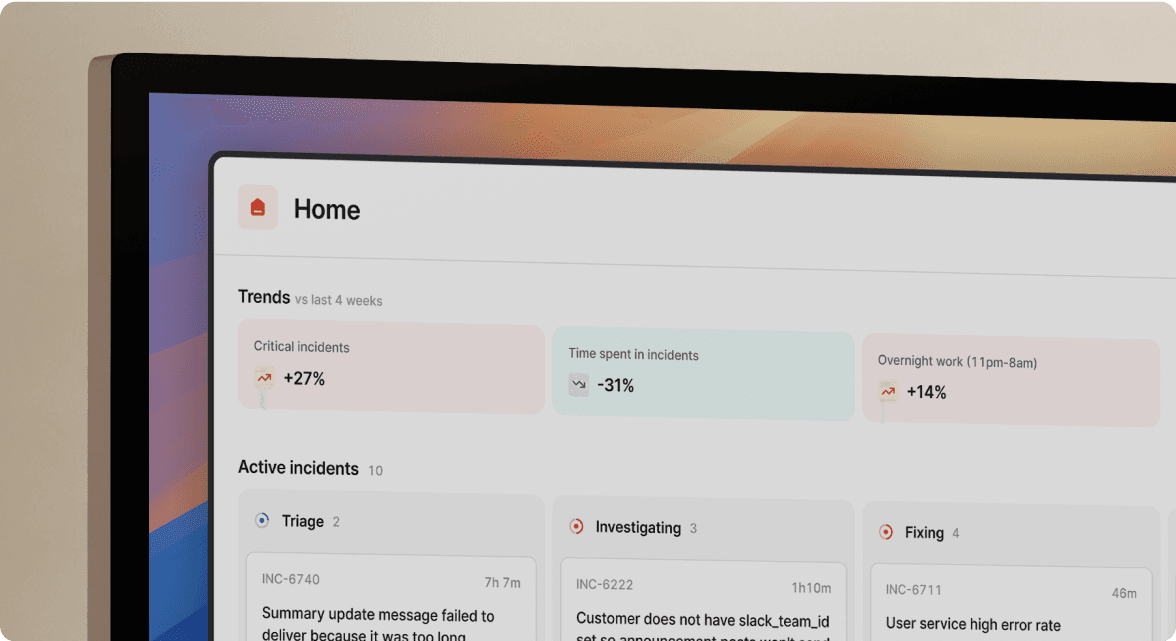Incident summaries with AI
November 14, 2023

When joining a new incident, the incident summary is the first place that responders and observers look to get up to speed. Sometimes though it can be time-consuming to ensure that the summary represents the most up-to-date version about what’s happening in an incident.
That’s why we’ve starting using AI to suggest a new summary when an incident is updated! So next time you type /inc update, watch for the suggestion in the thread. Here's a 2 minute video of this in action.

Note that you’ll only see a suggestion when there’s enough information to produce a good summary, and the existing summary is starting to go stale. You can also make these suggestions better by letting our AI consider conversation in the channel (instructions for enabling this are here).
The recap modal has been upgraded
We’ve implemented another change to help keep observers up to date: we’ve revamped the “recap” modal so that it includes a bar of handy links, the options to subscribe / unsubscribe to an incident, as well as request an update.
We’ll now refer to this as the “overview” modal.

🚀 What else we’ve shipped
New
- CSV exports of incidents now include the Slack channel name and URL
- You can now type in any valid Jira label, even if it hasn't been used in your Jira account before
/inc retrospectivenow sends you to the web dashboard to create a retrospective incident- You can now use the catalog to filter drop-downs in custom fields based on the value of another custom field
Improvements
- We now support code blocks in internal status page updates
- The layout of status page dashboard updates is more spacious
- If we fail to resolve an incident on PagerDuty when you resolve your incident, we'll now show a clear message
- Updated the cancel and save buttons on integration settings pages to align with the design of the rest of our app
- Restructured our Slack subscription messages to make them easier to parse
- We now group users when assigning roles, actions and follow-ups so that it’s easy to find the most active members of an incident
- If you use the 📣 reaction to create an update, we'll now clean up the "should we share an update from this message?" prompt
- The 'Text' catalog attribute type is now called 'Rich text,' to clarify how it's different from 'String'
Bug fixes
- Unsubscribing from status page emails now actually unsubscribes the user
- The GitHub integration will now only be marked as broken when the credentials are invalid or expired
- Deleting a catalog entry that backs a customer status page or sub-page now removes the page; We no longer cause the dashboard to error
- Using a duplicate path for your sub-pages or customer pages will now show an error instead of silently failing
- We'll now mark the OpsGenie integration as broken when the API token has insufficient permissions
- Internal status pages now use your local time zone rather than UTC
- The 'declare retrospective incident' form won't ask which incident type to use if you only have one type configured
- We'll now prevent you from deleting a catalog type if it's used to power a custom field
- In drop-downs, we used to show the same option twice in some cases. Now we don't!
- Prevent monthly insights emails and policy reports from being sent twice around daylight savings time.
- When editing an internal status page's component definition, we now remember what filters you've applied before
- Slack channel names in the public API were occasionally wrong if multiple incidents had the same name.
- We fixed a bug that when declaring a retrospective incident, if you enabled the 'use an existing channel', you then couldn't then change your mind
- When using a template to export to Jira from Slack, all drop-downs now have options available
- When exporting a follow-up to Jira from Slack, labels can now be searched
- Previews for query expressions now work for all query expressions
So good, you’ll break things on purpose
Ready for modern incident management? Book a call with one of our experts today.

We’d love to talk to you about
- All-in-one incident management
- Our unmatched speed of deployment
- Why we’re loved by users and easily adopted
- How we work for the whole organization



